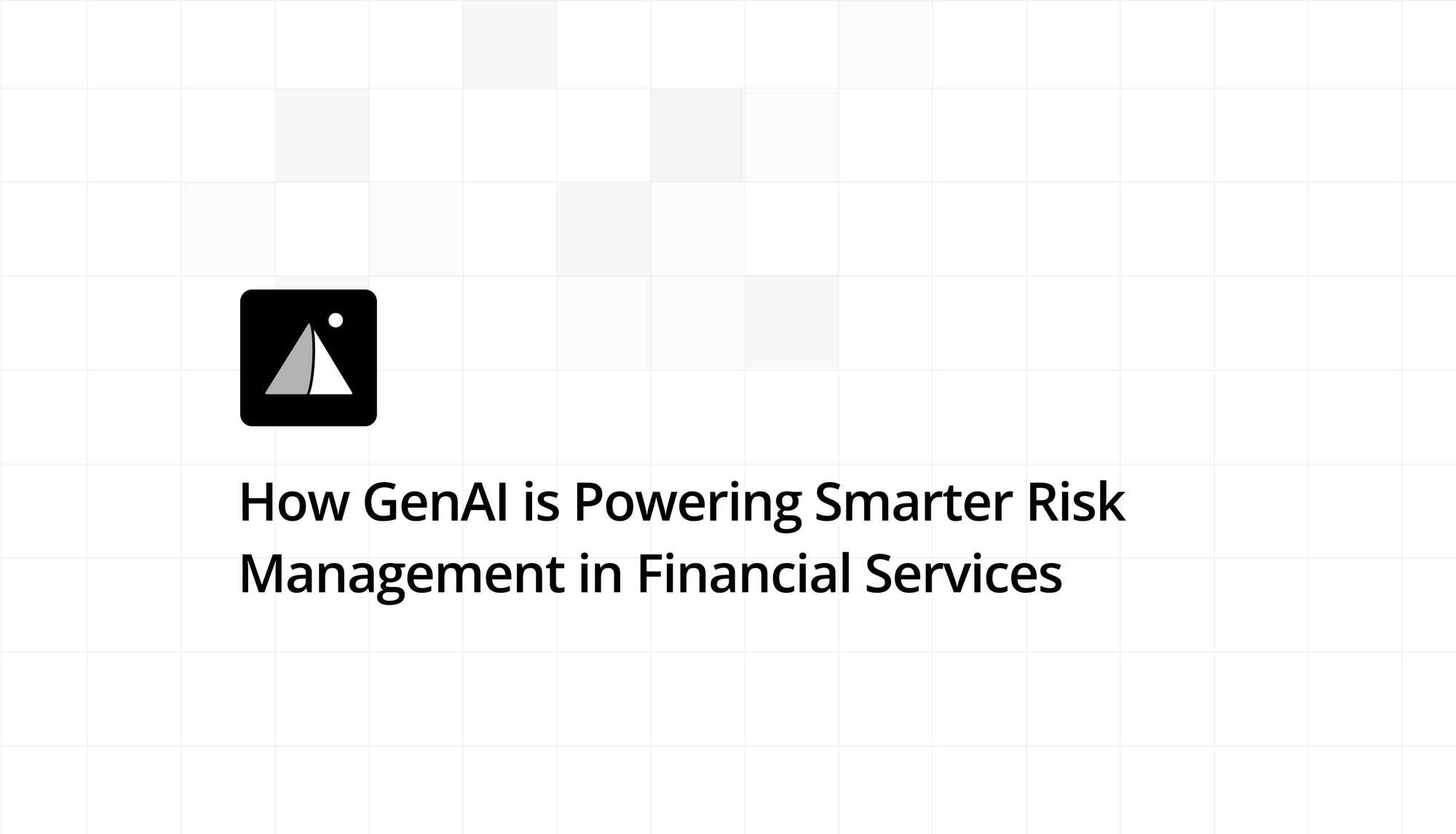- Fraud Detection: Real-time analysis boosts detection accuracy by 30% and reduces false positives by 60%.
- Credit Risk Prediction: Speeds up high-risk client monitoring by 25% and cuts manual review time by 40%.
- Compliance: Automates regulatory monitoring, saving time and reducing errors.
- Cybersecurity: Enables real-time threat detection and automated responses.
Why it matters: GenAI helps financial institutions centralize risk intelligence, lower costs, and improve efficiency. By leveraging AI for smarter decisions, banks can stay ahead of evolving risks while maintaining compliance.Key Takeaway: To remain competitive, financial institutions must adopt GenAI for proactive and efficient risk management.Revolutionizing FinTech: The Power of Generative AI in Fraud Detection, Risk Management, and More
GenAI Applications in Financial Risk Management
GenAI’s ability to create unified risk profiles has made it a powerful tool in areas like fraud detection, credit risk, compliance, and cybersecurity.
Fraud Detection and Prevention
VISA‘s Account Attack Intelligence (VAAI) system leverages GenAI to combat payment fraud in real time [2]. This technology specializes in identifying synthetic identity fraud by offering real-time analysis, advanced pattern recognition, and predictive analytics. The results? A 30% improvement in detection accuracy and a 60% drop in false positives, all while reducing response times.
But GenAI’s capabilities don’t stop at fraud prevention. It’s also reshaping how financial institutions handle credit risk.
Credit Risk Prediction
One global bank integrated GenAI into its customer profiling system and saw impressive results:
- 25% boost in efficiency for monitoring high-risk clients
- 40% cut in time spent on manual profile reviews [6]
- Real-time updates to customer risk scores
Compliance and Regulatory MonitoringGenAI scans regulatory texts and compares them with a bank’s internal policies, streamlining compliance processes.
"GenAI can fundamentally change financial institutions' risk management by automating, accelerating, and enhancing everything from compliance to fraud detection and predictive analytics."

McKinsey
Position
Beyond compliance, GenAI is a key player in tackling cybersecurity challenges and ensuring operational resilience.
Cybersecurity and Operational Risks
J.P. Morgan is a prime example of GenAI’s impact on cybersecurity. The system processes unstructured data to deliver real-time insights into complex systems. Benefits include real-time threat detection, continuous system monitoring, automated incident response, and AI-powered scenario planning – all while improving payment capabilities [2].
Implementing GenAI in Risk Management
For financial institutions, successfully using GenAI in risk management means building strong frameworks that balance compliance and operational efficiency. This involves focusing on critical areas like data quality, model transparency, system integration, and ethical practices.
Data Quality and Governance
Accurate risk assessment starts with high-quality data. Automated data validation, clear lineage tracking, and continuous monitoring can improve accuracy by 25%. For example, a global bank achieved a 40% reduction in data errors and a 60% boost in efficiency by implementing a strong data governance framework [1].
Transparent and Explainable AI Models
Transparency is crucial for staying compliant. ValidMind highlights the importance of rigorous processes:
To achieve this, financial institutions should prioritize detailed documentation, use tools like SHAP for explainability, and conduct thorough bias testing to ensure fairness and accountability.
Integrating GenAI with Existing Systems
Seamless integration of GenAI requires a secure and scalable tech stack. This often includes RESTful APIs, cloud-based services, and automated testing frameworks. McKinsey points out:
By leveraging these tools, institutions can streamline processes and enhance system compatibility.
Ethical and Privacy Considerations
Meeting regulations like GDPR and the EU AI Act involves steps such as data anonymization, ethical impact assessments, and clear accountability measures. Banks that have adopted these practices report a 22% drop in operational costs while maintaining compliance [7].
Future Developments in GenAI for Risk Management
Financial risk management is changing fast, thanks to advancements in GenAI technology. As financial institutions adopt these tools, three areas stand out as transformative for the industry.
Advanced NLP Applications
Natural Language Processing (NLP) is becoming more powerful in assessing risks. According to McKinsey, GenAI-driven NLP systems can now analyze sentiments across multiple languages and data sources at the same time, offering real-time insights into market risks [1].
Here’s how NLP is reshaping risk management:
| NLP Application | Impact on Risk Management |
|---|---|
| Sentiment Analysis | Provides real-time market risk insights from news and social media |
| Contract Analysis | Automates the detection of legal risks in complex documents |
| Communication Monitoring | Improves compliance oversight across internal and external channels |
Quantum Computing and AI Integration
Combining quantum computing with GenAI is opening up new possibilities for managing risks. This pairing allows financial institutions to handle intricate risk scenarios at speeds that were previously unattainable [4]. It boosts capabilities like complex risk modeling, strengthens cryptographic measures, and ensures rapid market analysis.
Collaborative Risk Management with Federated Learning
Federated learning is changing how institutions collaborate on risk management. It lets banks securely share insights, building robust risk models while keeping data private. This strengthens the entire industry’s ability to manage risks effectively [4].
These technologies build on existing GenAI uses, such as fraud detection and compliance, pushing financial risk management into a new era. To stay competitive, institutions need to adopt these advancements strategically and proactively.
Conclusion: GenAI’s Role in Risk Management
How GenAI Enhances Risk Management
GenAI is reshaping financial risk management by automating tasks, boosting precision, and supporting forward-looking strategies. Its influence touches several key areas, delivering clear improvements in security, compliance, and overall efficiency.
Here’s a quick look at its impact:
| Area | Impact |
|---|---|
| Security and Operational Efficiency | Improved threat detection, minimized losses, smoother processes |
| Regulatory Compliance | Greater accuracy, reduced compliance costs |
| Risk Intelligence | More informed decisions, increased transparency |
By centralizing risk intelligence, GenAI is redefining how financial institutions approach risk. Its role in fraud detection and compliance has been especially impactful, helping institutions tackle new threats through advanced behavioral analysis [5].
A Call to Action for Financial Institutions
For financial institutions, adopting GenAI is no longer optional. As financial risks continue to evolve, those slow to integrate GenAI risk falling behind in both security and compliance.
To make the most of GenAI, institutions should:
- Start with pilot projects in compliance and risk areas
- Equip staff to work effectively alongside AI systems
- Adapt workflows to align with AI capabilities while prioritizing ethical considerations
Solutions such as AICamp‘s Multi-Model AI Access and Custom AI Assistants offer a powerful way for institutions to strengthen their risk management efforts. By focusing on high-quality data and maintaining ethical standards, financial institutions can unlock GenAI’s full potential while staying compliant [4].
FAQs
How is AI used in financial risk management?
AI is transforming financial risk management by tackling challenges in fraud detection, compliance, credit evaluation, and cybersecurity.
- Fraud Detection: AI analyzes behavioral patterns and transaction anomalies to spot potential fraud early. For example, it can flag suspicious activity and even replace compromised cards before fraud occurs. One financial institution reported a 40% improvement in identifying suspicious activities and a 30% increase in efficiency after implementing AI [3].
- Compliance and Regulatory Monitoring: AI simplifies compliance by identifying circular transfers, evaluating high-risk jurisdictions, and drafting Suspicious Activity Reports (SARs) in real time. Lucinity’s scenario-based transaction monitoring system is an example of how AI supports real-time detection while ensuring compliance with regulations.
- Credit Risk Assessment: AI processes large datasets to provide real-time insights for credit risk evaluation. This helps speed up decision-making and improves modeling for capital adequacy [1][4].
- Cybersecurity and Behavioral Analytics: AI enhances cybersecurity by continuously monitoring for unusual behaviors, such as irregular login patterns, inconsistent access locations, or unusual transactions. Tools like Elastic‘s AI-driven observability solutions allow institutions to detect threats early and take preventive measures while staying compliant [5].
These use cases highlight how AI is reshaping financial risk management, making processes more efficient and proactive.














